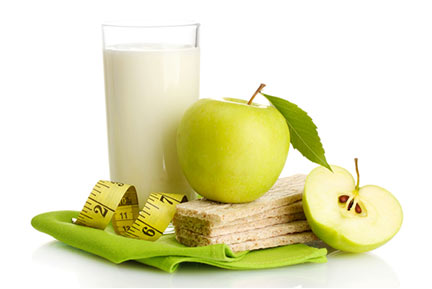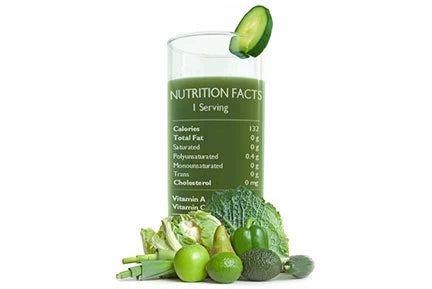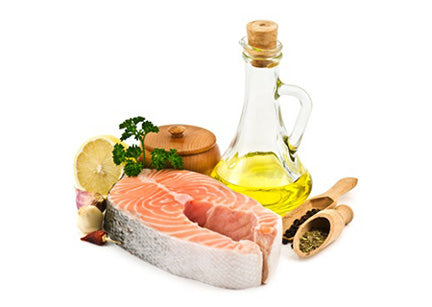 Roles and sources of natural vitamin C
Roles and sources of natural vitamin C
Ascorbic acid, also known as natural vitamin C, il the most famous and most consumed of all vitamins. Originally used as a cure for scurvy, vitamin C has since demonstrated its importance in many functions and processes in the organism, for instance to protect the walls of blood vessels, to produce collagen, in iron metabolism, to reinforce the immunitary system, etc. This molecule also possesses antioxidant properties, i.e. is able to protect against radical species that are known to disrupt the cellular structure and can even damage DNA [1].
Contrary to other mammals, humans (and more generally primates) are not able to synthesize vitamin C themselves, meaning that they must find this nutrient in their food. The recommended daily dose is set to 110 mg / day for adults, both men and women [2].
Natural vitamin C is mainly found in vegetables, fruits, and herbs such as blackcurrant, red pepper, kiwi, strawberry, parsley, etc. (Figure 1) and in even higher quantity in certain berries and fruits from Africa and South America [3]. However, vitamin C is a very fragile molecule that is highly sensitive to environmental conditions such as temperature, air, or light. This means that a significant amount of vitamin is lost during storage of fruit and vegetables or during cooking [2]. To make sure that the recommended daily dose is reached, it is possible to take multivitamin complements and other vitamin C supplements (later referred to as traditional vitamin C in this text) besides foods. These complements are generally available under various shapes (tablets, capsules, liquid, etc.) and different doses for easy digestion.
Effects and limits of traditional vitamin C
A few studies have aimed at evaluating the effects of large doses of traditional vitamin C by measuring its concentration in plasma. It was evidenced that ingesting high doses of vitamin C, typically more than 100 mg, does not end up in a higher concentration in plasma but instead leads to a threshold concentration (Figure 2) [4, 5]. In other words, ingesting high quantity of traditional vitamin C does not mean having more vitamin in the blood and in the organism [5]. This phenomenon is explained by the limited quantities of vitamin C that the intestines can absorb in a given time to redistribute to the rest of the organism (this phenomenon is known as bowel tolerance). The excess of vitamin C not absorbed by the intestine is eliminated in the urine and, to a lower extent, in feces [4]. Moreover, it must be pointed out that taking very high doses of traditional vitamin C can cause diarrhea and other digestive problems, although vitamin C itself is not toxic [6].

Evolution of vitamin C in plasma depending on the dose of traditional vitamin C ingested in a day
Alternatives to oral vitamin C complements
The intestines act as a barrier regulating the concentration of vitamin C in blood and, by extension, limits the efficiency of traditional vitamin C. One way to circumvent this barrier consists in injecting vitamin C in the blood (intravenous injection). By this mean, it is possible to reach concentrations in plasma 30 to 40 times higher than with oral complements. One unexpected benefit of intravenous injection is the possible anticancerous action of vitamin C and its potential help in cancer treatments [5]. However, injected vitamin C is still quickly eliminated from the bloodstream [7]. This implies that its “biodistribution”, i.e. its distribution in the human body, is time-limited and one or several injections may be required each day. Moreover, the natural degradation of vitamin C in blood, be it through oxidation by the oxygen dissolved in blood or through the action of gastric juices, also reduces the efficiency of vitamin C and must be taken into consideration. Lastly, it must be pointed out that daily injection or injections of vitamin C is highly inconvenient and is not adapted for a food supplement application.
All things considered, the optimal strategy to deliver vitamin C must:
- Protect vitamin C from degradation prior to being delivered to cells;
- Overcome bowel tolerance;
- Ensure that a high concentration of vitamin C is delivered in the whole body (increased biodistribution) and over a long period of time.
To meet these requirements, it is possible to encapsulate vitamin C into liposomes (referred to as liposomal vitamin C). Liposomes are vesicles that can stabilize and protect the vitamin and subsequently transport it to the cells. Liposomes were initially used in the pharmaceutical sector to deliver anticancerous compounds and other molecules used to treat various diseases and ailments. Since then, liposomes are employed in various fields such as cosmetics or food industry, for instance to stabilize iron and other nutrients in milk [8].
Liposomes: a revolutionary encapsulation method for a natural vitamin C with enhanced efficiency
Liposomes are vesicles consisting of a lipid bilayer, i.e. they act like “bubbles” made of lipids and possessing a diameter ranging from 20 nanometers (nm) to a few micrometers (μm) [8, 9]. By comparison, a human hair possess a diameter ranging between 50 and 100 μm (which is equivalent to 0.02 to 0.1 mm), which means that liposomes can be 100 to 1,000 times smaller than a hair diameter.
Initially employed as cell membrane models to test the effects of drugs during the 1960s (cell membranes are also lipid bilayers), liposomes have quickly proved to be powerful vectors to deliver active substances, enzymes, antimicrobial agents, but also pesticides for use in agriculture [10]. Their employ in the food industry is more recent but is attracting more and more attention and the number of scientific studies is constantly increasing.
A liposome structure consist in a lipid “bilayer” and an aqueous core, which is possible due to the amphiphilic nature of lipids. These molecules possess:
- A hydrophilic head, i.e. a portion that an affinity for water;
- A hydrophobic tail, i.e. a portion that avoids water.
As a result, when lipids come in contact with water, they will spontaneously organize themselves so as to minimize contact between water and hydrophobic tails. This translates by the formation of a bilayer, where hydrophobic tails face each other within the bilayer and get isolated from the aqueous medium around (Figure 3). This structure is enclosed and leads to the entrapment of an internal compartment - or core - where hydrosoluble compounds can be transported. Alternatively, hydrophobic compounds can also be encapsulated, in which case these molecules are directly incorporated into the lipid bilayer [11].
There exist different types of liposomes, classified according to their size and number of internal compartment. It is for instance possible to distinguish between unilamellar (with a single compartment) and multilamellar structures (when one liposome contains several compartments)

The structure and size of liposomes can be controlled by the type of lipid composing the vesicle as well as by the manufacturing method.
Contrary to proteins, vitamins, and other nutrients, lipids are less affected by the passage through the stomach and by the action of gastric juices and enzymes. Lipid digestion mainly proceeds in the small intestine [11]. The change of pH that occurs in the digestive tract does not seem to impact the stability of liposomes, but salts present in the bile as well as enzymes can disrupt the liposome membrane. However, even though some of the vesicles lose their integrity and release their content, other liposomes can withstand and are absorbed by intestines and are subsequently carried by the blood. From there, liposomes can get distributed throughout the whole body (“bioaccessibility”) [11].
(“intracellular release”). Since molecules are concentrated within each liposome (compared to free molecules that are diluted in the blood), the encapsulation within liposomes enables to deliver a higher dose of molecules directly within the cells.
Lastly, liposomes (and by extension liposomal vitamin C) offer a longer biodisponibility than free molecules circulating in the organism. Owing to their resistance to the gastrointestinal environment, liposomes are able to circulate for extended period of time in the blood prior to their excretion by the kidneys. As a result, treatments are efficient over a longer period of time, which can be modulated by the size of liposomes, the type of lipid forming their membrane, or by the addition of other molecules directly into or onto the membrane. These additional molecules help in making vesicles more resistant to the action of enzymes. They can also make liposomes invisible to cells of the immune systems (always ready to clear any foreign body from the organism), a strategy commonly used in the pharmaceutical industry [11].
The advantages of liposomal vitamin C
The encapsulation of nutrients within liposomes is an excellent strategy to improve their bioavailability and to ensure that most of the nutrients reach the cells for an optimal treatment. Vitamin C can benefit from such encapsulation (referred to as “liposomal vitamin C”), in particular because the hydrophilic nature of this molecules facilitate the vitamin C dissolution inside the aqueous core of liposomes [13].
Liposomal vitamin C offer several advantages over their traditional counterpart:
- Protection of vitamin C from degradation following the passage through the gastrointestinal tract (from gastric juices, enzymes, change of pH, oxydation, etc.) due to the insulation created by the liposome membrane;
- No coloring agent or preservative;
- Liposomes circumvent the bowel tolerance and the limitation of vitamin C concentration in blood thanks to their better absorption by the intestines;
- No diarrhea or digestive disorders related to high doses of vitamin C due to the insulation by the vesicles;
- Better distribution throughout the body and higher concentration of liposomes - and then of vitamin C - in the blood compared to free vitamin C;
- Enhanced absorption by the cells owing to the similar nature of cells and liposome membrane and their special affinity;
- Improved action of liposomal vitamin C following the higher concentration of vitamin C directly released within cells;
- A longer action duration thanks to the longer bioavailability of liposomes, which allows a release of vitamin C over a longer period of time.
In summary, liposomal vitamin C is the most efficient strategy to reach the recommended daily uptake of vitamin C. The encapsulation in liposomes overcomes most of the challenges that traditional vitamin C must face and does not suffer from the limitations of intravenous injection. Yet, one must be cautious regarding the quality of liposomes: many tutorials aiming at teaching you how to prepare liposomes yourself are available. However, these tutorial do not guarantee the size or even the formation of liposomes, let alone their efficiency.
For an optimal efficacy, only raw materials of the highest quality must be used. Moreover, the liposome size must comply to specific standards and their characteristics must be validated by independent tests. Liposomal vitamin C 500 mg from Goldman laboratories meet these strict requirements and make sure to deliver natural vitamin C complements based on a real encapsulation technology. Only by trusting products of the highest quality can you benefits from the advantages of this revolutionary encapsulation method.
References:
[1] : Human Vitamin and Mineral Requirements, Report of a joint FAO/WHO expert consultation. World Health Organization. 2012 (http://www.fao.org/3/y2809e/y2809e00.htm#Contents)
[2] : https://www.anses.fr/fr/content/vitamine-c-ou-acide-ascorbique
[3] : https://observatoire-des-aliments.fr/sante/les-dix-meilleures-sources-de-vitamine-c
[4] : Levine M., Padayatty J., Espey M.G. Vitamin C: A Concentration-Function Approach Yields Pharmacology and Therapeutic Discoveries. Adv Nutr. 2011 Mar;2(2):78-88
[5] : Padayatty S. Vitamin C Pharmacokinetics: Implications for Oral and Intravenous Use. Annals of Internal Medicine. 2004;140(7):533.
[6] : Cathcart R.F. Vitamin C, titrating to bowel tolerance, anascorbemia, and acute induced scurvy. Med Hypotheses. 1981 Nov;7(11):1359-76
[7] : http://campus.cerimes.fr/nutrition/enseignement/nutrition_10/site/html/3.html
[8] : Khaniri E, Bagheripoor-Fallah N., Sohrabvandi S. Application of liposomes in some dairy products. Crit Rev Food Sci Nutr. 2016;56(3):484-93
[9] : Davis J.L, Paris H.L., Beals J.W. Liposomal-encapsulated Ascorbic Acid: Influence on Vitamin C Bioavailability and Capacity to Protect Against Ischemia-Reperfusion Injury. Nutr Metab Insights. 2016 Jun 20;9:25-30
[10] : Taylor T.M., Davidson P.M., Bruce B.D. Liposomal nanocapsules in food science and agriculture, Crit Rev Food Sci Nutr. 2005;45(7-8):587-60
[11] : Liu W., Ye A., Han F. Advances and challenges in liposome digestion: Surface interaction, biological fate, and GIT modeling. Adv Colloid Interface Sci. 263 (2019) 52-67
[12] : Duzgunes N., Nir S. Mechanisms and kinetics of liposome–cell interactions. Adv Drug Deliv Rev. 1999 Nov 10;40(1-2):3-18
[13] : Lorin A., Clore C., Thomas A. Les liposomes : description, fabrication et applications. Biotechnol. Agron. Soc. Environ. 2004 8 (3), 163–176





